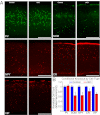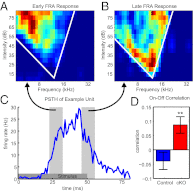Chronic reduction in inhibition reduces receptive field size in mouse auditory cortex
- PMID: 22753490
- PMCID: PMC3427089
- DOI: 10.1073/pnas.1205909109
Chronic reduction in inhibition reduces receptive field size in mouse auditory cortex
Abstract
Inhibitory interneurons regulate the responses of cortical circuits. In auditory cortical areas, inhibition from these neurons narrows spectral tuning and shapes response dynamics. Acute disruptions of inhibition expand spectral receptive fields. However, the effects of long-term perturbations of inhibitory circuitry on auditory cortical responses are unknown. We ablated ~30% of dendrite-targeting cortical inhibitory interneurons after the critical period by studying mice with a conditional deletion of Dlx1. Following the loss of interneurons, baseline firing rates rose and tone-evoked responses became less sparse in auditory cortex. However, contrary to acute blockades of inhibition, the sizes of spectral receptive fields were reduced, demonstrating both higher thresholds and narrower bandwidths. Furthermore, long-latency responses at the edge of the receptive field were absent. On the basis of changes in response dynamics, the mechanism for the reduction in receptive field size appears to be a compensatory loss of cortico-cortically (CC) driven responses. Our findings suggest chronic conditions that feature changes in inhibitory circuitry are not likely to be well modeled by acute network manipulations, and compensation may be a critical component of chronic neuronal conditions.
Conflict of interest statement
The authors declare no conflict of interest.
Figures





Comment in
-
Consequences of chronic reduction of cortical inhibition.Proc Natl Acad Sci U S A. 2012 Aug 21;109(34):13473-4. doi: 10.1073/pnas.1210409109. Epub 2012 Aug 3. Proc Natl Acad Sci U S A. 2012. PMID: 22864915 Free PMC article. No abstract available.
Similar articles
-
Influence of a subtype of inhibitory interneuron on stimulus-specific responses in visual cortex.Cereb Cortex. 2012 Mar;22(3):493-508. doi: 10.1093/cercor/bhr057. Epub 2011 Jun 10. Cereb Cortex. 2012. PMID: 21666125 Free PMC article.
-
Diversity of Receptive Fields and Sideband Inhibition with Complex Thalamocortical and Intracortical Origin in L2/3 of Mouse Primary Auditory Cortex.J Neurosci. 2021 Apr 7;41(14):3142-3162. doi: 10.1523/JNEUROSCI.1732-20.2021. Epub 2021 Feb 16. J Neurosci. 2021. PMID: 33593857 Free PMC article.
-
Consequences of chronic reduction of cortical inhibition.Proc Natl Acad Sci U S A. 2012 Aug 21;109(34):13473-4. doi: 10.1073/pnas.1210409109. Epub 2012 Aug 3. Proc Natl Acad Sci U S A. 2012. PMID: 22864915 Free PMC article. No abstract available.
-
Parvalbumin-expressing inhibitory interneurons in auditory cortex are well-tuned for frequency.J Neurosci. 2013 Aug 21;33(34):13713-23. doi: 10.1523/JNEUROSCI.0663-13.2013. J Neurosci. 2013. PMID: 23966693 Free PMC article.
-
Network-Level Control of Frequency Tuning in Auditory Cortex.Neuron. 2017 Jul 19;95(2):412-423.e4. doi: 10.1016/j.neuron.2017.06.019. Epub 2017 Jul 6. Neuron. 2017. PMID: 28689982 Free PMC article.
Cited by
-
Prefrontal Cortex GABAergic Deficits and Circuit Dysfunction in the Pathophysiology and Treatment of Chronic Stress and Depression.Curr Opin Behav Sci. 2017 Apr;14:1-8. doi: 10.1016/j.cobeha.2016.09.012. Curr Opin Behav Sci. 2017. PMID: 27812532 Free PMC article.
-
Bidirectional homeostatic plasticity induced by interneuron cell death and transplantation in vivo.Proc Natl Acad Sci U S A. 2014 Jan 7;111(1):492-7. doi: 10.1073/pnas.1307784111. Epub 2013 Dec 16. Proc Natl Acad Sci U S A. 2014. PMID: 24344303 Free PMC article.
-
Glycine receptor α2 subunit activation promotes cortical interneuron migration.Cell Rep. 2013 Aug 29;4(4):738-50. doi: 10.1016/j.celrep.2013.07.016. Epub 2013 Aug 15. Cell Rep. 2013. PMID: 23954789 Free PMC article.
-
Dlx1 and Dlx2 Promote Interneuron GABA Synthesis, Synaptogenesis, and Dendritogenesis.Cereb Cortex. 2018 Nov 1;28(11):3797-3815. doi: 10.1093/cercor/bhx241. Cereb Cortex. 2018. PMID: 29028947 Free PMC article.
-
Tinnitus Correlates with Downregulation of Cortical Glutamate Decarboxylase 65 Expression But Not Auditory Cortical Map Reorganization.J Neurosci. 2019 Dec 11;39(50):9989-10001. doi: 10.1523/JNEUROSCI.1117-19.2019. Epub 2019 Nov 8. J Neurosci. 2019. PMID: 31704784 Free PMC article.
References
-
- Markram H, et al. Interneurons of the neocortical inhibitory system. Nat Rev Neurosci. 2004;5:793–807. - PubMed
-
- Tan AYY, Zhang LI, Merzenich MM, Schreiner CE. Tone-evoked excitatory and inhibitory synaptic conductances of primary auditory cortex neurons. J Neurophysiol. 2004;92:630–643. - PubMed
-
- Wehr M, Zador AM. Balanced inhibition underlies tuning and sharpens spike timing in auditory cortex. Nature. 2003;426:442–446. - PubMed
Publication types
MeSH terms
Substances
Grants and funding
- MH049428/MH/NIMH NIH HHS/United States
- P50 MH077970/MH/NIMH NIH HHS/United States
- DC02260/DC/NIDCD NIH HHS/United States
- T32 GM007449/GM/NIGMS NIH HHS/United States
- K99 MH085946/MH/NIMH NIH HHS/United States
- MH077970/MH/NIMH NIH HHS/United States
- R37 MH049428/MH/NIMH NIH HHS/United States
- R01 MH049428/MH/NIMH NIH HHS/United States
- MH085946/MH/NIMH NIH HHS/United States
- GM007449/GM/NIGMS NIH HHS/United States
- R01 DC002260/DC/NIDCD NIH HHS/United States
- MH089920/MH/NIMH NIH HHS/United States
- T32 MH089920/MH/NIMH NIH HHS/United States
- R00 MH085946/MH/NIMH NIH HHS/United States
LinkOut - more resources
Full Text Sources
Molecular Biology Databases

